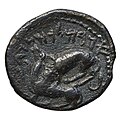The Kings of Byblos were the rulers of Byblos, the ancient Phoenician city in what is now Lebanon.
Scholars have pieced together the fragmented list from various archaeological finds since the 19th century.
Early period
Some kings of Byblos from an early period are known from Egyptian and local finds:
- Ib-dadi, contemporary of Amar-Sin.
- Abishemu I, probably contemporary of Amenemhat III.
- Yapi-shemu-abi, contemporary of Amenemhat IV.
- Yakin-ilu, contemporary of Sehetepibre I/II.
- Yantin-ʿammu, contemporary of Zimri-Lim, probably identical to Yantin, contemporary of Neferhotep I.
- Ilima-yapi? - a prince, not explicitly of Byblos.
- Ḥasrurum son of Rum, a ruler of the land of Byblos, probably contemporary of Sihathor.
- Abishemu II.
- Yapaʿ-shemu-abi, son of Abishemu (probably the second).
- ʿegel, son of Abishemu (probably the second), probably identical to ʿegliya (whose father name is unknown).
Egyptian period
- Rib-Hadda, writer of dozens of Amarna letters. c.1340s BC.
- Ili-Rapih, writer of two of Amarna letters. c.1320 BC.
- Aziru (King of the Amurru kingdom), c.1320? BC.
- Zakar Baal, mentioned in Story of Wenamun. 1100s BC.
Phoenician golden age
See also: Byblian royal inscriptions- 1000s BC Ahiram
- c.1000 BC Zakar Baal (II?)
- c.980 BC Ithobaal? Pilsibaal?
- c.940 BC Yehimilk
- c.930 BC Abibaal
- c.920 BC Elibaal
- c.900 BC Safatba'al (I)
Assyrian period
Ashurnasirpal II received tributes from the kings of the sea coast, among them the king of Byblos.
- Safatba‘al II (Sibitti-biʿil in Akkadian), mentioned among the kings of who brought payment to Tiglath-Pileser III in his 8th year (738 BC).
- Urumilki (Ūru-milki in Akkadian), mentioned in a list of the kings of the land Amurru (the Levant) who brought tribute to Sennacherib in his campaign in the Levant.
- Milkiashapa (Milki-ašapa in Akkadian), mentioned among the kings of the Levant and Cyprus who were summoned and ordered to send tribute to Esarhaddon, c.670 BC. Milki-Ashapa is also mentioned in the first campaign of Ashurbanipal.
- c.650 BC Yehawmelek
Persian period
- c. 500 BC Safatba'al (III)
- c. 480 BC Urimilk II
- c. 470 BC Yeḥarbaal (son of Urimilk II)
- c. 450 BC Yehawmilk (son of Yeḥarbaal)
Based on coins:
- c. 425 BC Elpaal (’LP‘L)
- c. 400 BC ‘Ozbaal (‘ZB‘L; son of Batnoam and the priest Paltibaal)
- c. 375 BC Urimilk III (’WRMLK)
- 332 BC ‘Aynel (‘YN’L; Enylus), who cooporated with Alexander the Great in the siege of Tyre.
Roman period
- 68 BC Cinyrus
See also
References
- Kitchen, K. A. (1967). "Byblos, Egypt, and Mari in the Early Second Millennium B.C.". Orientalia. 36 (1): 39–54. JSTOR 43074138.
- Kitchen, K. A. (1967). "Byblos, Egypt, and Mari in the Early Second Millennium B.C.". Orientalia. 36 (1): 40–42. JSTOR 43074138.
- See also Albright, W. F. (1964). "The Eighteenth-Century Princes of Byblos and the Chronology of Middle Bronze". Bulletin of the American Schools of Oriental Research (176): 38–46. doi:10.2307/1355576. ISSN 0003-097X. JSTOR 1355576. S2CID 163708413.
- Knudtzon, Jørgen Alexander (1915). Die El-Amarna-Tafeln. Vol. 1. Hinrichs’schke Buchhandlung. letters EA 68–93, 95, 102–138 (and EA 96, sent to Rib-Hadda).
- Knudtzon, Jørgen Alexander (1915). Die El-Amarna-Tafeln. Vol. 1. Hinrichs’schke Buchhandlung. letters EA 139, 140.
- "Wenamen's Journey". Reshafim. Archived from the original on 2013-01-21.
- Albert Kirk Grayson (1991). Assyrian Rulers of the Early First Millennium BC I (1114–859 BC). University of Toronto Press. pp. 218–219.
- Tadmor, Hayim; Yamada, Shigeo (2011). The Royal Inscriptions of Tiglath-Pileser III, King Of Assyria (744-727 BC) And Shalmaneser V (726-722 BC), Kings of Assyria. Eisenbrauns. pp. 44, 46–47 (the passage repeats in pp. 70, 77, 123, 133).
- Kirk Grayson, A.; Novotny, Jamie (2012). The royal inscriptions of Sennacherib, king of Assyria (704-681 BC). Part 1. Eisenbrauns. pp. 64 (the passage repeats in pp. 114, 131, 175, 192).
- Kirk Grayson, A.; Novotny, Jamie (2014). The royal inscriptions of Sennacherib, king of Assyria (704-681 BC). Part 2. Eisenbrauns. pp. 183, 188, 238.
- Leichty, Erle (2011). The Royal Inscriptions of Esarhaddon, King of Assyria (680-669 BC). Eisenbrauns. pp. 23–24 (the passage repeats in pp. 46).
- Novotny, Jamie; Jeffers, Joshua (2018). The Royal Inscriptions of Ashurbanipal (668–631 BC), Aššur-etel-ilāni (630–627 BC), and Sîn-šarra-iškun (626–612 BC), Kings of Assyria, Part 1. Eisenbrauns. pp. 116–117 (the passage repeats in pp. 141–142). This part of the first campaign is not described in the early versions of the pescription, as explained in p. 109.
- Sader, Hélène (2019). The History and Archaeology of Phoenicia. Atlanta: SBL. pp. 85–86. ISBN 978-1-62837-255-7.
- Slouschz, Nahoum (1942). Thesaurus of Phoenician Inscriptions (in Hebrew). Dvir. p. 14.


